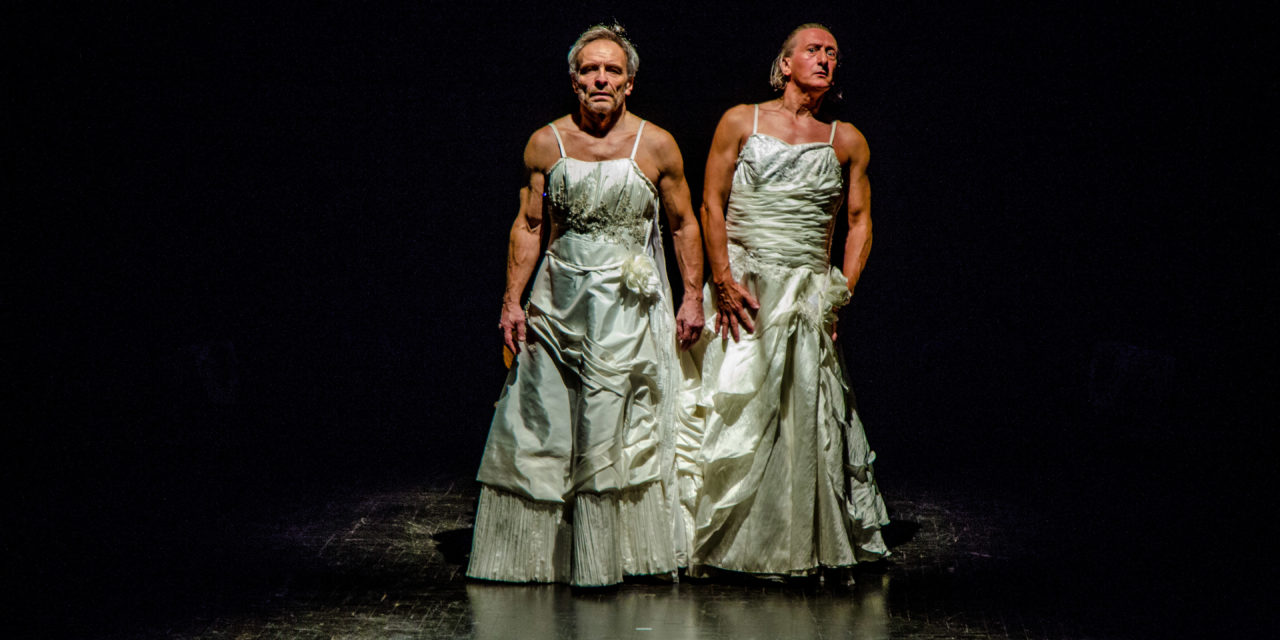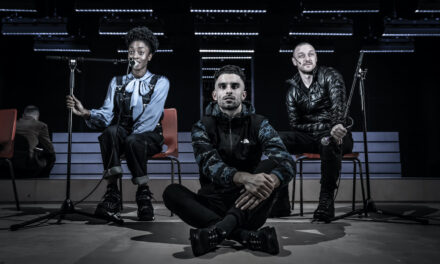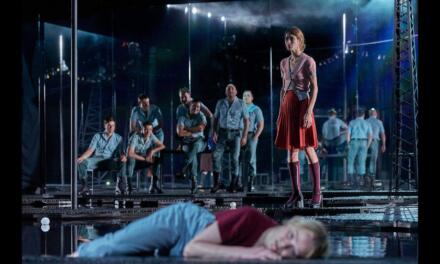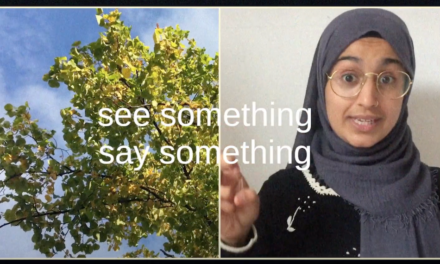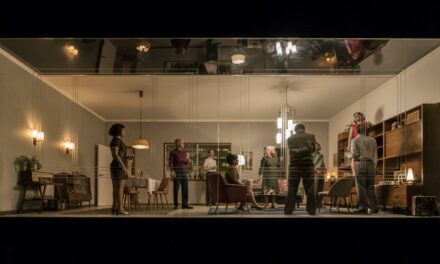For the last three years, liberal, pro-European Poland has been experiencing an identity crisis. It seems that the demons have been brought to the forefront: religious obscurantism, anti-Semitism, xenophobia, and sexism. Cultural and intellectual openness has been replaced with populism and nationalism. The Theatre of the Eighth Day (Teatru Ósmego Dnia) does not remain indifferent to these processes. As in the days of communism, it takes the side of the open society. In the face of propaganda, a nationalistic-oriented vision of history, this theatre is the voice of conscience. A cry for reflection, a critical look at the civic community. The group’s performances are a testimony to their remaining on the freedom barricades.
A homage to Judith Malina
The performance And they pitched a tent among us (I rozstawili namiot wśród nas) was authored by two actors from the Eighth Day Theatre: Adam Borowski and Marcin Kęszycki. The authors of the live music are Szczepan Kopyt (vocals, guitar, harmonica) and Piotr Kowalski (drums). The first of them is known as an anarchist, anti-system poet. They have been playing together for years. The music co-creates the performance. It announces accidents and comments on events taking place. The musicians undertake a dialogue with the actors appearing on stage. This artistic dialogue evokes the music roots of happenings. This is not the only reference to the times of the second avant-garde. The performance is a homage to Judith Malina from the Living Theatre. The icon of a countercultural protest, a figure important for the actors of the Eighth Day Theatre, she died on April 10, 2015, at Lillian Booth Actors Home in New York. At the end of her life, she was evicted from the theatre at Clinton Street in New York. Judith Malina is a figure beyond stereotypes: the daughter of a rabbi with Polish roots, an anarchist, revolutionist and theatre reformer. And a deeply religious person. She liked to sit on a bench in Central Park, like the heroine of Janusz Głowacki’s drama Antigone in New York.
Malina is one of two named women, the heroines of the performance. The second is Elżbieta Zielińska. Evicted from a flat in Gdansk, she has pitched her tent on the lawn in Poznań, between the tracks of a fast tram and a traffic street. As a nomad, she lived like this for several years. She had a fridge, a deckchair, an umbrella. The border of her camp was marked by flowers planted in pots. For inhabitants, she was a disturbing stranger, going beyond stereotypical ideas about normal life. For the municipal authorities, she was a problem. She was not an alcoholic or a drug addict, she did not wrangle about, she did not steal. She did not show pathological tendencies or mental disorders. Finally, with the general satisfaction of residents and bureaucracy, she was displaced to her native Gdańsk. There she left the homeless shelter and all traces of her were lost. Disturbingly different, she became an enemy.
![<em>I rozstawili namiot wśród nas</em> [<em>And they pitched a tent among us</em>], Teatr Ósmego Dnia [Theatre of the Eight Day], Photograph by Maciej Włodarczyk.](https://thetheatretimes.com/wp-content/uploads/2018/03/1.-And-they-pitched-a-tent-among-us.jpg)
I rozstawili namiot wśród nas [And they pitched a tent among us], Teatr Ósmego Dnia [Theatre of the Eight Day], Photograph by Maciej Włodarczyk.
Who is this story about?
The performance is about these others: strangers, excluded, unadapted. And about Poland as the land of refusal: intolerance, rejection, discrimination. It begins with the tent-setup scene. An allegory of existential minimalism, only the most necessary equipment. Among them, an old tape recorder, from which Mozart was once heard, and a suitcase covered with stickers from around the world. This is Zielińska’s camp. But also a reminiscence of the journey of the Theatre of the Eighth Day and maybe of the Living Theatre too. A journey to meet the world and inside a man. A reminiscence of heroic avant-garde times. Anyway, in a moment, the stage platforms-bulldozers will do the work of destruction. Before that the actors, like flight attendants, will inform spectators of the rules of theatrical flight safety.
Who is this story about? The two actors cannot decide. For Marcin K., this is supposed to be a story about two aged actors, capitalizing on their old fame. It is meant to be funny. Andrzej B. wants it to be a spectacle about two women: Malina and Zielińska. In the end, he convinces his colleague to practice these roles. This scene is important. He recalls Grotowski’s acting practices and Meyerhold’s biomechanics method. But it is also a choice, meeting with otherness. The bodies of Adam B. and Marcin K. hardly fit into women’s white dresses.
This is a very feminist scene; it refers to the social corset imposed on women by tradition, patriarchal culture. But it also has a wider context. Before the stage of the Young Ladies Dance, Adam B. says:
And I’m afraid that some garden gnomes forbid me to kiss in public places,
they will prohibit eating ham sandwiches, mini skirts, theories of evolution, dance, beauty and even love.
I’m scared when there are boats in the sea with thousands of thirsty people.
I’m afraid a little girl who survived Sarajevo’s fire
and now she is a young woman to the question: “what are you most afraid of today?” he will again say: “people.”
I am afraid of people when they become a crowd, vibrating meat
with burning torches and eyes, with Kalashnikov automatic-gun on the neck!
So this is a show about fear. The fear of the epigons of the 1968 revolution, the heroes of the counterculture and the political opposition to new times. But also the fear of how the open society of the West will behave towards the immigrants who are knocking on its door: reject and exclude them? To others who are looking for their place, not always gentle and grateful? Will it respond with aggression, fearing acts of terrorism? The visualization of this fear is a scene with a jar-trapped mosquito (Aedes albopictus) whose bite spreads tropical diseases. It evokes unambiguous associations. Especially given that it is followed by a dance with a Kalashnikov automatic gun, a popular weapon of extremists. The choreography is a repetition of the Young Ladies Dance, only the movements are more decisive, angular. After the dance, the most important scene takes place: the story of a child named Faris, a tale of fear, wandering, suffering and loss.
Mummy always says Dad will find us and cry. I am praying to Allah and I am asking for my Dad to find us. There are so many people here, but I pray that Dad will come to us.
The tale of Faris is not the story of a specific person. It is a construction, made up of many stories of exiles. It does not lose its authenticity.
![<em>I rozstawili namiot wśród nas</em> [<em>And they pitched a tent among us</em>], Teatr Ósmego Dnia [Theatre of the Eight Day], Photograph by Maciej Włodarczyk.](https://thetheatretimes.com/wp-content/uploads/2018/03/3.-And-they-pitched-a-tent-among-us-1024x683.jpg)
I rozstawili namiot wśród nas [And they pitched a tent among us], Teatr Ósmego Dnia [Theatre of the Eight Day], Photograph by Maciej Włodarczyk.
Connecting Aleppo to Polish past
A car may, like a boat, be a vehicle transferring one to a better, richer world. We are watching two refugees in the drivers’ pantomime. For me, this scene is like a bridge connecting the experiences of refugees from Aleppo with Polish martial law emigrants in the 1980s. Then not only political exiles but also economic ones, they got through the communist border to the West. I remember a joke from those times: “The last one (leaving Poland – KŚ) turns off the light.” It is a pity that nowadays most of my compatriots no longer remember this experience and close the door to refugees. The escape ends with a traffic accident, just like dreams usually bring disappointment in the face of reality. Only the vision remains.
Refugees from the bottom of the ocean are watching a better world: glass skyscrapers, toll highways, Banksy graffiti. And the big inscription: “Emigrants not welcome.” The world is not for them. Even if they find themselves in it, they are condemned to live in the lower spheres of the social hierarchy. Before that, however, they must overcome barbed wire fences. And the curse of a Hungarian farmer. Then, the images of Poland emerge: religious pilgrimages to Catholic sanctuaries, prayerful crowds, patriotic slogans and a complete lack of empathy for those in need. But somewhere in a worse world:
Adam B.: Muezzin’s hoarse voice calls for prayer
Men in Toyota fast pickups
With the quick-fire weapon, the city of Kobanî is conquered
A woman with a blanket and a plastic bucket
She is heading towards a closed border
Marcin K.: The sea is thrown onto the beaches
A rag doll, polka dot dress, wooden toy car,
Children, faces blurred in accordance with the provisions on image protection.
The pixels on the bottoms of the ocean are roaming
The world is getting smaller and smaller. The utopia of McLuhan’s global village is being fulfilled. The epilogue of the performance is a parable, in which the fate of the Polish homeless, American artists and refugees from the hell of Aleppo, and all other hells of today’s world, are connected. On stage, in the dark and with music, Adam B. and Marcin K. set up a camp. It consists of miniature tents. Each of them is illuminated inside. For a moment among them:
Colorful “guards” appear. Their Kalashnikov automatic-gun are rainbow and extraordinary. They are watching . . . They disappear after a while. The light goes out. Only illuminated tents . . .
The guards are watching. Are UN soldiers sent to stabilize the situation in the region? Or maybe the guardian angels of the exiles? Visualizations of dreams of a safe life? Joanna Ostrowska in her review of the play found analogies to the Jewish holiday of Sukka.(1) Perhaps, however, the illuminated tents refer to Hanukkah. The light gives you warmth and a sense of security. Even if it is only temporary. Hope is born.
And they pitched a tent among us
Scenario, costumes and direction: Adam Borowski, Marcin Kęszycki
Cast: Adam B. and Marcin K.
Music: Szczepan Kopyt and Piotr Kowalski
Choreography: Kacper Lipiński
Premiere: 2015.11.19
Notes
Ostrowska, J. Święto namiotów, http://teatralny.pl/recenzje/swieto-namiotow,1307.html
This post was written by the author in their personal capacity.The opinions expressed in this article are the author’s own and do not reflect the view of The Theatre Times, their staff or collaborators.
This post was written by Klaudiusz Święcicki.
The views expressed here belong to the author and do not necessarily reflect our views and opinions.

